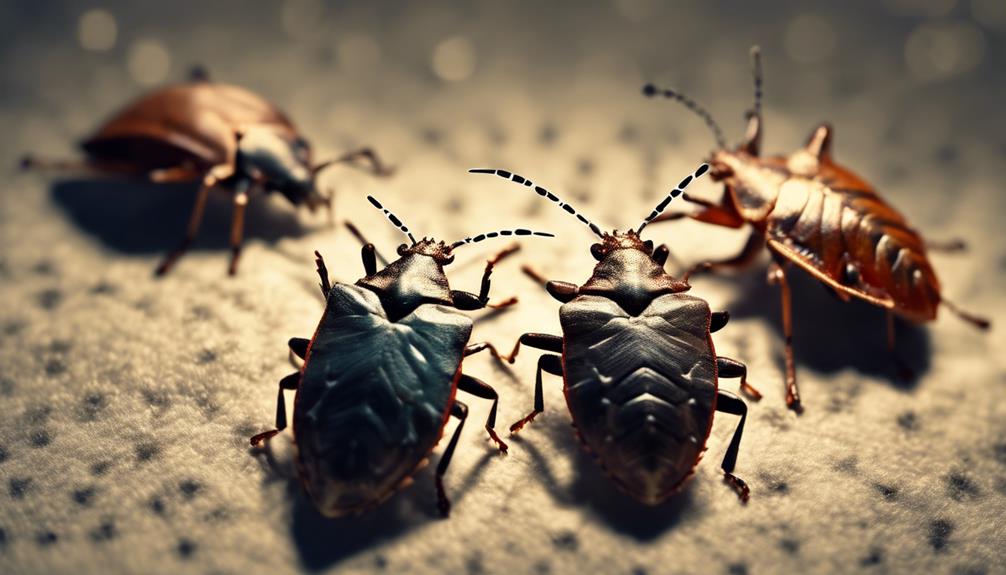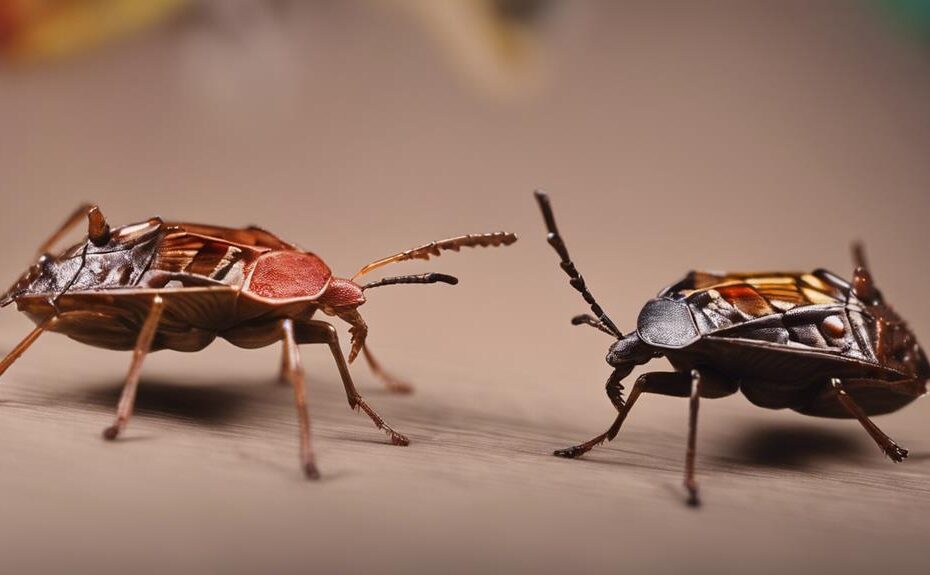When it comes to household pests, stink bugs and bed bugs are two common nuisances that can cause distress to homeowners. Both insects have distinct characteristics that set them apart, from their appearance to their behaviors.
Understanding the differences between stink bugs and bed bugs can help individuals identify and address infestations effectively. By examining various factors such as diet, infestation signs, and control methods, a clearer picture emerges of these pests' impact on living environments.
Let's explore how stink bugs and bed bugs differ in these aspects and what steps can be taken to manage their presence.
Appearance
In distinguishing between stink bugs and bed bugs based on appearance, one notable characteristic is the distinct shape and coloration of their bodies. Stink bugs, belonging to the Pentatomidae family, typically exhibit a shield-like shape with a color variation that includes shades of brown, green, or gray. Their bodies are often marked with patterns or bands, contributing to their camouflage abilities.
In contrast, bed bugs, scientifically known as Cimex lectularius, have a more oval and flat body structure with a reddish-brown hue. Another key point of differentiation lies in their wing length. Stink bugs possess membranous wings that are folded neatly over their abdomens, whereas bed bugs lack wings entirely.
Understanding these physical attributes is crucial in correctly identifying and addressing infestations, as mistaking one for the other can lead to ineffective control measures. By closely examining the coloration and wing characteristics, individuals can enhance their ability to accurately differentiate between stink bugs and bed bugs.
Behavior
Studying the behavior of stink bugs and bed bugs reveals distinct patterns in their feeding habits and nocturnal activity. Bed bugs are known for their nocturnal feeding behavior, preferring to feed on human blood while the host is asleep. In contrast, stink bugs are active during the day, feeding on a variety of plants by piercing them with their mouthparts.
When it comes to communication patterns, bed bugs use pheromones to communicate with each other, particularly to signal alarm or attract mates. Stink bugs, on the other hand, rely more on vibrational signals to communicate within their colonies.
In terms of nesting habits, bed bugs tend to hide in cracks and crevices near their food source, which is often the host's sleeping area. Stink bugs, however, prefer to gather in large numbers on plants or in other outdoor locations during warmer months. Below is a table highlighting key behavioral differences between stink bugs and bed bugs:
| Behavior | Stink Bugs | Bed Bugs |
|---|---|---|
| Nocturnal Activity | Active during the day | Active during the night |
| Communication | Vibrational signals | Pheromones |
| Nesting Habits | Gather in large numbers on plants outdoors | Hide in cracks and crevices indoors |
Diet

During their respective life cycles, stink bugs and bed bugs exhibit distinct dietary preferences that contribute to their survival and reproductive success. Stink bugs, scientifically known as Pentatomidae, are herbivores that primarily feed on plants, fruits, and tree sap. They use their piercing mouthparts to extract nutrients from various plant tissues, causing damage to crops and ornamental plants.
In contrast, bed bugs, belonging to the Cimicidae family, are obligate blood feeders that rely on mammalian blood for sustenance. Bed bugs feed exclusively on the blood of humans and animals, typically emerging at night to bite their hosts and consume a blood meal.
Although stink bugs and bed bugs differ significantly in their dietary preferences, both insects share similarities in their feeding habits. They use specialized mouthparts to access their food sources, piercing through plant tissues or human skin to extract nutrients or blood. Additionally, both stink bugs and bed bugs exhibit a preference for specific hosts or plant species, which influences their distribution and behavior.
Infestation Signs
Detecting the presence of an infestation by either stink bugs or bed bugs involves observing specific signs characteristic of each insect's activity.
- Identification Techniques:
- Stink Bugs: Look for a foul odor, especially when disturbed or crushed. These bugs also emit a strong scent when present in large numbers.
- Bed Bugs: Check for small reddish-brown bugs in mattress seams, bed frames, and headboards. Look for dark spots or bloodstains on bedding, a common sign of bed bug activity.
- Both: Keep an eye out for shed exoskeletons, fecal stains, or eggs, which can indicate a thriving bug population.
When dealing with an infestation, prevention is key. For stink bugs, sealing entry points like cracks and crevices can help. For bed bugs, regular inspections of bedding and furniture are crucial. Treatment options vary from DIY methods to professional extermination strategies, depending on the severity of the infestation. Consulting with pest control experts can provide tailored solutions for effective bug removal.
Control Methods

Implementing effective control methods is essential in managing infestations of stink bugs and bed bugs to prevent further spread and damage. When dealing with stink bugs, chemical treatments are commonly used. Insecticides containing pyrethroids or neonicotinoids are effective in controlling stink bug populations. These chemicals disrupt the nervous system of the bugs, leading to paralysis and eventual death. However, it is important to follow safety guidelines when using chemical treatments to avoid harm to humans, pets, and beneficial insects.
For those looking for natural remedies to control stink bugs, options such as diatomaceous earth, garlic spray, or insecticidal soap can be effective. These natural alternatives offer a safer option for controlling stink bugs without the use of harsh chemicals.
In the case of bed bugs, chemical treatments are also commonly employed. Insecticides like pyrethroids, desiccants, or insect growth regulators are used to target bed bug infestations. Proper application and thorough treatment of affected areas are crucial for successful eradication. Additionally, non-chemical methods such as heat treatments or vacuuming can also aid in controlling bed bug populations effectively.
Conclusion
In comparing stink bugs and bed bugs, it is evident that their behavior and infestation signs differ significantly.
Stink bugs are primarily plant feeders, while bed bugs are blood-feeding insects that dwell close to their hosts.
Understanding these distinctions is crucial for implementing effective control methods tailored to each pest's unique characteristics.
Pest Behavior Comparison
Upon analyzing the behavior patterns of stink bugs and bed bugs, it becomes evident that their distinct characteristics influence their interactions within their respective environments.
Stink bugs are known to emit a foul odor as a defense mechanism, while bed bugs are more stealthy in their activities, often feeding on human hosts undetected.
The pest activity differences between stink bugs and bed bugs are quite pronounced, with stink bugs being more active during the day and bed bugs predominantly active at night.
Additionally, the behavioral tendencies comparison reveals that stink bugs tend to gather in large numbers on plants or trees, while bed bugs prefer to hide in cracks and crevices near their food source.
Infestation Signs Comparison
After examining the distinct behavioral patterns of stink bugs and bed bugs, the comparison of infestation signs serves as a crucial aspect to differentiate between the two pest species. Stink bug infestations are often identified by the foul odor they emit when threatened or crushed, along with the visible presence of the bugs congregating on the exterior walls of buildings.
In contrast, bed bug infestations are typically characterized by small red bites on the skin, bloodstains on bedding, and tiny dark excrement spots on sheets or mattresses. To prevent these infestations, individuals should be vigilant in pest identification and implement effective prevention techniques.
In cases of severe infestations, professional extermination may be necessary, while milder cases might be resolved through DIY solutions.
Control Methods Overview
Implementing a comprehensive pest control plan is essential to effectively manage and eradicate infestations of stink bugs and bed bugs, ensuring a pest-free environment. When dealing with these pests, it is crucial to consider various control methods.
Here are some options to help combat stink bugs and bed bugs:
- Chemical Treatments: Utilize insecticides specifically formulated to target stink bugs and bed bugs.
- Natural Remedies: Explore natural alternatives like diatomaceous earth or essential oils to repel or eliminate these pests.
- Integrated Pest Management (IPM): Implement a holistic approach that combines various control methods to reduce pest populations effectively.
Frequently Asked Questions
Can Stink Bugs and Bed Bugs Coexist in the Same Environment?
When considering the coexistence of different insect species in a shared habitat, factors such as competition for resources, environmental conditions, and behavioral interactions play crucial roles.
Stink bugs are known for their distinct behavior of emitting foul odors as a defense mechanism, while bed bugs exhibit habits of feeding on blood and hiding in cracks and crevices.
Understanding the dynamics of these behaviors can shed light on the potential for coexistence in homes.
Do Stink Bugs and Bed Bugs Pose Any Health Risks to Humans?
Stink bugs and bed bugs can both pose health risks to humans.
Stink bugs may cause skin irritation and allergic reactions if handled or crushed, while bed bugs are known to cause discomfort, itching, and skin rashes from their bites.
Prevention methods for both include good hygiene practices and regular inspection of living spaces.
Symptoms of stink bug exposure can be managed with antihistamines, whereas bed bug bites may require topical corticosteroids for relief.
Are There Any Natural Predators That Can Help Control Stink Bug and Bed Bug Populations?
Natural predators play a vital role in controlling pest populations through biological control. These predators are an integral part of the ecosystem, preying on pest species and helping to maintain balance in nature.
The effectiveness of natural predators in controlling populations of various pests depends on a range of factors such as predator-prey interactions, environmental conditions, and availability of alternative food sources.
Implementing biological control measures can be a sustainable and eco-friendly approach to managing pest populations.
Can Stink Bugs and Bed Bugs Cause Damage to Furniture or Property?
Furniture damage caused by pests like stink bugs and bed bugs can be significant, leading to costly repairs or replacements. Prevention methods such as regularly inspecting furniture, using protective covers, and maintaining a clean environment can help mitigate potential damage.
Similarly, property damage from these pests can be extensive, necessitating effective extermination techniques like vacuuming, heat treatments, or professional pest control services to eradicate infestations and safeguard property integrity.
Are There Any Specific Geographic Regions Where Stink Bugs or Bed Bugs Are More Prevalent?
Invasive species can thrive in specific geographic regions due to factors like climate, habitat, and food availability. Pest management strategies are often tailored to address the prevalence of these species in different areas.
Understanding the distribution and prevalence of invasive pests like stink bugs and bed bugs is crucial for effective control measures. By identifying high-risk regions, authorities can implement targeted interventions to mitigate the impact of these pests on agriculture, ecosystems, and human dwellings.
Conclusion
In conclusion, stink bugs and bed bugs differ in appearance, behavior, diet, and infestation signs.
Stink bugs are characterized by their shield-shaped bodies and emit a foul odor when disturbed, while bed bugs are small, reddish-brown insects that feed on blood.
Control methods for these pests vary and require specific strategies tailored to each species.
Understanding these differences is crucial in effectively managing infestations and maintaining a pest-free environment.

